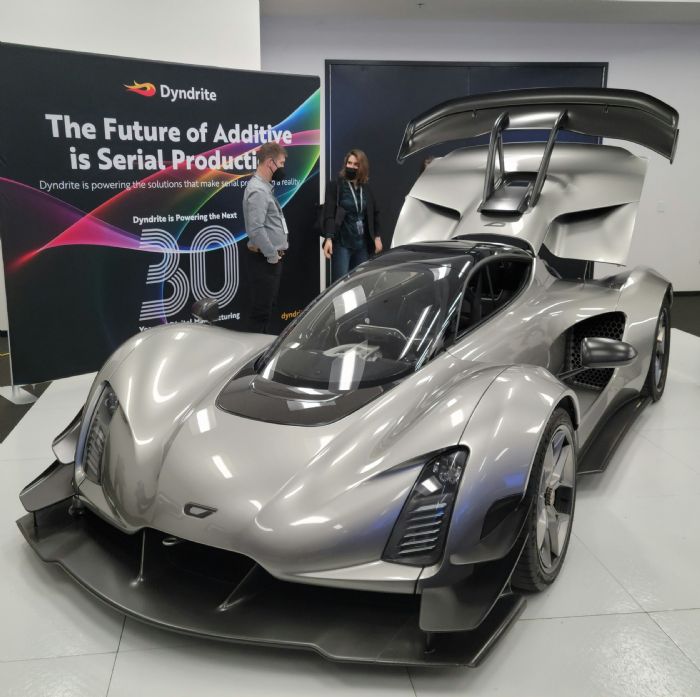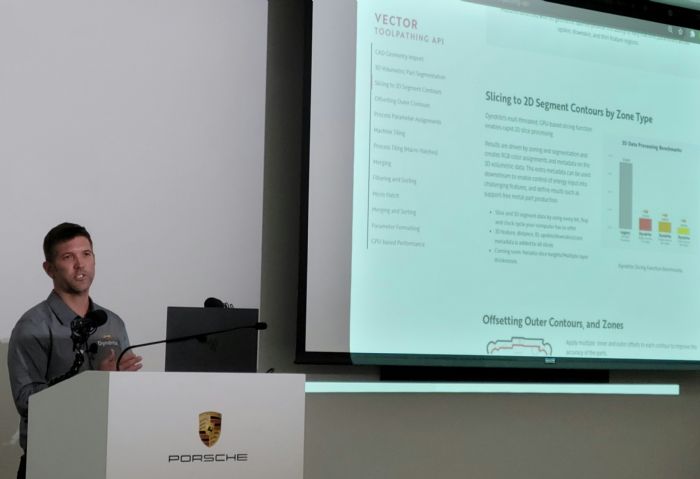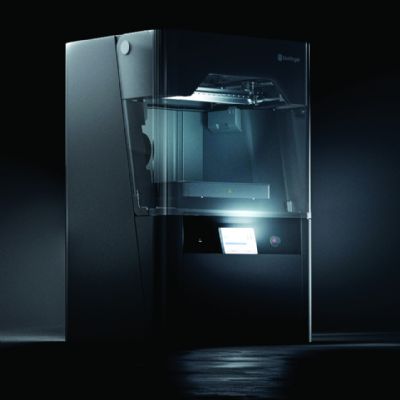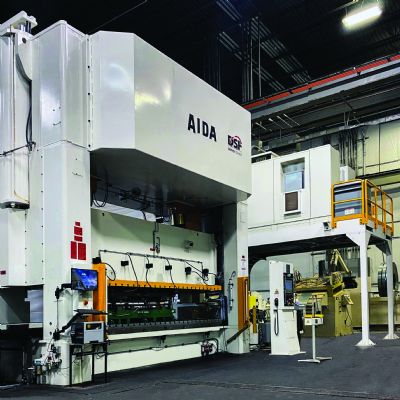Users reportedly can quickly qualify new geometries, machines and materials using geometric operations to compensate for challenges associated with process physics. This technology opens the door to transparent and shareable toolpathing recipes that are not locked behind an OEM IP wall and hidden from the end user, offers Harshil Goel, Dyndrite CEO. “Anyone can now make a recipe and share it,” he says. “New recipes can be explored, tested and qualified faster.”
The more that a 3D printer understands what it’s printing, the more likely it will print it correctly, reason Dyndrite developers in forwarding this API. Layer-by-layer interrogation strategies today enable machines to see up a few layers and down a few layers, providing a “2.5D” look into a 3D part, according to Goel. Unfortunately, according to the developers, this method misses certain feature cases leading to failed prints, or cumbersome work-arounds.
In computational terms, Dyndrite’s new 3D volumetric part-segmentation capability surpasses existing layer-by-layer-based boolean toolpathing methodologies by
utilizing its GPU-based voxel engine to enable true 3D geometric queries into
any part. Further, the 3D fields are thresholded and booleaned to enable the
assignment of different parameters within a single model. This zoning process
allows one to develop robust build strategies that match the geometry being
printed, for example resolving large and small features at the resolution of
the machine, assigning high-throughput strategies for thicker sections, or
implementing machine-based support strategies without having to split CAD
models into discrete components.
“Generating toolpaths, or instructing a machine on exactly how to build your part, is critical to that part’s ultimate success, especially as the types of parts, materials and machine capabilities advance,” Goel says, explaining the reasoning behind this API and its capabilities. “Machine makers and their customers require more sophisticated tools to be able to consistently deliver quality parts, especially, for example, heat exchangers, turbines and other difficult-to-print geometries, at faster speed.”
What does 3D volumetric part-segmentation offer?
According to Dyndrite officials:
- Volumetric 3D assignment of parameters on each segment based on a number of variables, including distance from upward or downward faces, nearest surface, etc., while avoiding inefficient 2.5D up-skin/down-skin calculations. This allows users to generate “feature-aware” machine tiles; use geometry to programmatically determine finely graded process parameters; accurately calculate upskin, downskin, orifice and fine vertical features; and compensate for other physical differences in a machine, such as laser angle-of-incidence.
- Creation of an unlimited number of thresholds,
using the API, delivers accurate parameters to each condition in the build. Distance
thresholds are assigned colors, enabling the use of correct parameters for
extremely challenging geometries such as thin walls, vertical features and
overhangs.
“True volumetric analysis enables us to identify features that cannot be found using 2.5D analysis of layer data,” says Steve Walton, Dyndrite head of product, who demonstrated product features and impressive analysis time savings to event attendees (pictured). “It also allows us to develop more sophisticated toolpath strategies in the vicinity of fine features that are generated using any method: CAD geometry, mesh data from 3D scanning or implicit geometry. This goes far beyond layer booleans used to determine upskin and downskin. Now we can use 3D fields to assign parameters throughout the build.”
Dyndrite’s Toolpathing API enables detailed assignment of parameters throughout the entire workflow, including:
- Offsetting outer contours and zones—apply multiple inner and outer offsets to each contour to improve the accuracy of the parts
- Process-parameter and machine-constraint assignments—assign geometric and tool parameters to each zone, segment type and layer
- Machine tiling—tiling parameters can be programmatically applied regardless of how many zones are in place
- Process tiling (macro hatches)—create tiling/tessellation on each 2D contour to distribute the physical process in-chamber
- Merging, sorting and filtering—post-process all previously created
tiles for practical use of the tool and determine tool exposure based on
metadata filters, queries, sorting and machine constraints such as gas flow
- Micro hatch—create hatch geometry inside of the 2D contours from previously used steps.
 In addition to the technology unveiling, Dyndrite welcomed Kevin Czinger, founder and chief executive officer of Divergent Technologies, who in his keynote speech discussed development of the 1250-hp road-ready Czinger C21 Hybrid Hypercar (pictured), which travels 0-60 mph in 1.9 sec. Production calls for 80 of these mostly 3D-built vehicles.
In addition to the technology unveiling, Dyndrite welcomed Kevin Czinger, founder and chief executive officer of Divergent Technologies, who in his keynote speech discussed development of the 1250-hp road-ready Czinger C21 Hybrid Hypercar (pictured), which travels 0-60 mph in 1.9 sec. Production calls for 80 of these mostly 3D-built vehicles.
He also discussed Divergent's digital production system, Divergent Adaptive Production System (DAPS), which “radically transforms auto manufacturing economics and environmental impact using a data-driven approach for designing and building vehicle structures,” according to company officials.
As the company’s website describes, “Divergent has invented a complete manufacturing solution to address system level challenges. DAPS is a complete software/hardware solution designed to replace traditional vehicle manufacturing—a complete modular digital factory for complex structures. Given a set of digital requirements as input, the machine automatically computationally engineers, additively manufactures and assembles any complex structure. The system is able to move seamlessly between manufacturing different vehicle models.”
Look for more on the ideas behind digital production in future issues of 3D Metal Printing.
See also: Dyndrite Corp.
Technologies:
 At a special event in early October, Dyndrite
unveiled its raster- and vector-based Toolpathing application programming interface
(API), which enables OEMs and end users to develop print recipes for previously
impossible or difficult-to-print builds. Industry additive manufacturing (AM)
providers and suppliers converged on the Porsche Experience Center in Los
Angeles, CA, to learn more about the API, with many attendees lauding
computational speed that enables feature analysis within seconds as compared to
hours, and from simpler computing devices rather than bulked-up
engineering-optimized workstations.
At a special event in early October, Dyndrite
unveiled its raster- and vector-based Toolpathing application programming interface
(API), which enables OEMs and end users to develop print recipes for previously
impossible or difficult-to-print builds. Industry additive manufacturing (AM)
providers and suppliers converged on the Porsche Experience Center in Los
Angeles, CA, to learn more about the API, with many attendees lauding
computational speed that enables feature analysis within seconds as compared to
hours, and from simpler computing devices rather than bulked-up
engineering-optimized workstations.





 In addition to the technology unveiling, Dyndrite welcomed Kevin Czinger, founder and chief executive officer of
In addition to the technology unveiling, Dyndrite welcomed Kevin Czinger, founder and chief executive officer of 

